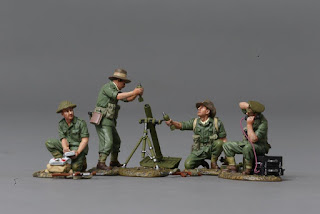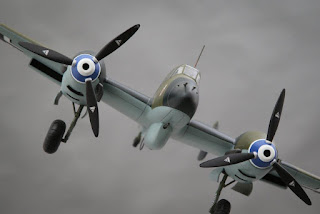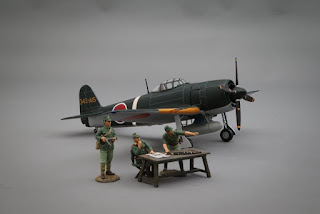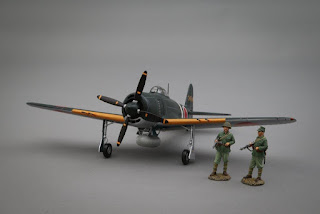BY DAN VERSSEN GAMES
What I'm going to say may have started to become a touch familiar, nay repetitive, if you have read my previous reviews of DVG games, especially as they have all been from the Leader stable of games. Is it my fault that their production quality is some of the finest and most reliable in the hobby ? There's no getting away from the fact that they put out consistently top-notch physical components - unboxing is a sheer delight - and this from a company much smaller than all the really big names.
My one and only slightly adverse criticism of the new edition of U-Boat Leader and its American counterpart Gato Leader was the small size of mounted main gaming board and the fact that DVG then published as an "expansion" a decent sized board for them along with some fairly irrelevant plastic ships. Well, Tiger Leader, which came out a year before them in 2015, hasn't even got that minor blip!
I'd go so far as to say that it is one of my favourite game boards in their series. It's a four-panel, mounted board and fractionally over the standard 22" x 17" folio size that many companies put out as paper maps. In the central play area is a magnificent sepia map of the Ardennes where that last desperate throw of the Third Reich, namely the Battle of The Bulge, took place. Even more amazing is that this map is ultimately purely eye-candy, as once the main "Battle" Phase of the game gets under way, it is overlaid by six generic terrain pieces [in the same fashion as the earlier Thunderbolt/Apache Leader game]. Equally odd is that out of the nine excellent campaigns the game offers, the Bulge isn't included.
How can you leave out the Bulge? [sob]
However, as a war gamer who cut his teeth on hexes, these large, four-hex tile overlays are very impressive. They are made of substantially thick, durable, glossy card-stock: double-sided so that you can fight in three different terrain localities - Europe, Desert and Winter. They get a big, loud "Len's 10" from me [apologies that that metaphor's probably only understandable in the UK, not sure how many countries we've sold it to - so other nationalities can google "Strictly Come Dancing"]. So too do the two counter sheets that include the substantial numbers of Polish, French, Russian and American troops to fight against.
Along with the units are a wide range of Damage markers, one side for Armour damage, the other for Infantry damage, the inevitable red Stress markers, enemy Battalion counters and, of course, your own German units.
Ultimately, you will be selecting some of those evocative Tiger tanks, but if you're like me that will be some time in the future, as there are nine Campaigns to choose from starting with Poland 1939, France 1940, Russia, North Africa and Europe 1944. There's nothing to stop you dashing on to those legendary monsters and don't let me stop you. Perhaps it's just my OCD tendency, but I like to work my way gradually through the historical time-line!
And, naturellement, in a DVG product, lots of lovely cards to drool over [didn't I tell you I always sleeve mine - now you know why!] : German unit cards, German Commander cards, Battalion cards [in three types - Assault, Supply and Command] Event cards, Special Condition cards and Objective cards. Some of them will be placed on the main mounted board called the Tactical Display Sheet, that I've already waxed lyrical about, some on the large card-stock display called the Head Quarters [sic - yes, it really is divided into two words]Sheet. Not sure where you quarter your arms, legs, etc!
Apart from the map section I've already detailed, the two separate Displays provide you with Holding boxes for all those lovely cards, a detailed Sequence of play and enough information to just about cover all aspects of the game without reference to the rule book. This tends to be a good feature of this series, but is for me one of the strongest and most workable examples in those games I possess.
As always the Rule Book is very substantial in quality and detail, following what I've come to recognise as their signature design. First comes the Campaign Set-Up taking you step by step through each process while enumerating all the relevant details about the counters and the cards with carefully labelled and itemised pictures, exactly when needed. Though, in one way, there is more detail here, each step is so easy and straightforward that I've found the process simpler than expected.
Select one of the nine Campaigns and a specific Objective. Each Campaign will tell you the difficulty level, any additional Special Ops points [SOs], the terrain type and the Commander Skill levels and any special features. The Objective card next provides how many SOs you have available to spend on buying units and other resources, the number of weeks the Campaign lasts, Battalion points for randomly selecting the necessary enemy Battalion cards, specific rules modifications to the Campaign and the Evaluation table to determine your level of success at the end.
If you are totally new to the Leader series of games, this may already be making you wonder if this game is for you, all I can say is that it is a very smooth process and reads far more dauntingly than the actual execution of what I'm describing. Though my developed familiarity with the overall systems may have influenced my next statement, I genuinely believe - and I am being as objective as possible - that this game is easier to learn, flows more smoothly overall and plays more quickly. What I have also found is that it is just as easy to lose!
The next step is one that appeals to me. In the previous DVG games I've reviewed your unit and its commander were one and the same. Buy a submarine and you choose one of the cards that represent the vessel and named commander at different levels of ability usually from Recruit to Ace, the same with your planes that were governed by the level of the pilot's skill. In Tiger Leader, the SOs you've been allocated are for buying purely the units that you will use to fight the Campaign - a few more SOs may come your way during the following weeks of fighting - but by and large most of what you buy now will be what you're stuck with as they suffer and get shot up or eliminated.
[Here's a typical combination of a machine-gun team and some transport. They don't have to go together, but the combo allows your vehicle to move your men forward and then both the transport and the infantry can fire. If the infantry are by themselves they can either move or fire, not do both.]
Then you choose, for free, one Commanding officer for each unit. Once again, each of these Commanders do come in six levels of ability. What prevents you just grabbing an Ace for each unit is the Campaign card that designates how many of each level of ability you may choose for up to seven units. For example, the Polish campaign allows you 3 Recruit, 2 Green*, 1 Average and 1 Skilled Commander. You'll notice that one level of Skill is starred. Any units that you buy above seven have to be allocated another of the starred levels. So, if I bought nine units I'd end up with 4 Green Commanders in total.
[Tank Commander Dietrich hopefully on his way to Ace status, with all the necessary stats. Notice that, like the images used for units, these aren't photo shots but sketches.]
Another very good wrinkle is that the assignment of Commander to unit can be changed at the beginning of each week. You have three categories of units: Infantry, Armour and Unarmoured - obviously each type of unit must have the relevant type of Commander. No giving an Armour Commander to an Infantry unit.
The next step is to draw a Special Condition card that will affect all the Battles in a given week.
One of the beneficial Special Condition cards - overall these cards have a balance of positive and negative effects and many of the negative ones can be cancelled by paying SO points.
Then it is decision time. How many Battalions am I going to choose to fight at the start of the week and which of my units am I going to allocate to take on each Battalion? Just choose one and send in all your men and you'll probably gain an easy victory, probably reaping about 3 VPs. Do that for any of the Campaigns that last three weeks and you'll end up with about enough VPs to earn yourself an Evaluation ranging from Dismal to the lowest level of Adequate.
[ Just one of your likely adversaries, a fairly meaty Infantry Support Battalion. ]
One advantage of this game is that you don't lose any VPs for your own units and Commanders that are eliminated.
So, it's off to our first Battle of the week and the draw of an Event card which normally will affect only this particular battle.
As with Special Condition cards, about half have good, half bad outcomes. Notice here a very familiar image - one of its earliest manifestations being a stylised version on the 1st edition of the famous Squad Leader game.
Six random tiles are drawn to form the battlefield; you place your units on the bottom row of map hexes and the enemy units' positions are randomly selected by dice rolls in the top two hex rows of the map. Most Battles last five turns. As with previous Leader games, your units that have a Fast Commander will activate first to move and/or shoot, then all the enemy ones and finally all your units with Slow Commanders. A very satisfying, simple chart and a single die roll provides the A.I. for enemy movement.
Here is the set-up of my forces in an early Campaign with a tank, machine-gun unit and transport in the light cover on the left flank and two more tanks on the right flank.
Combat too is very easy with a few, typical modifiers, such as terrain. For you, hit the enemy and it is eliminated - couldn't be simpler. For the hits scored by enemy units, it's draw one of the double-sided Damage markers and apply the appropriate side of the marker: either Infantry or Armour. As a result your units tend to survive longer than the enemy ones, as they may take several different types without being eliminated, though two of the same type usually will kill. There is the rare chance of an Explosion and bye-bye unit and Commander. It is rare, but in the second week of my first campaign, I had three tanks and each turn the Explosion damage was drawn when a unit shot at a tank. Don't say I didn't warn you!
At first sight this asymmetrical procedure for Combat may seem to hand it to the Germans on a plate. Experience of playing the game disproves that notion. The range of damage, the limited ability to remove some of it between each week of Battle, the choice of a Commander who might help in the process, all add greatly to the narrative produced by the game and this draws you in to the atmosphere of the game.
To defeat a Battalion you have to destroy a set number of unit points, but there is also a point at which the Battalion is reduced to half strength [gaining you half the VPs]. So, you may decide, if possible, to avoid further combat by manoeuvre - not always an easy thing to do - until the end of this Battle and return the next week to finish the Battalion off with a fresh force.
Standard to all the Leader series is the Post Combat phase at the end of each week, when Experience is logged and possibly spent to upgrade the ability of a Commander, if he has earned enough points, attempt repairs and replacements depending on whether you've gained SOs and acquire new Commanders if any have been killed in the previous week's fighting.
Personally, I've had a thoroughly good time with this game. The different elements introduced have greatly appealed . Among these are the Operational Display on which your enemy Battalions are placed according to information on their Unit card and the rule that means they may advance or retreat week by week, the Tactical Movement chart already mentioned, the difference of having a map and terrain to fight and manoeuvre over, the combination of unit and Commander discussed in more depth earlier, the flavour given by the Damage chits and learning the best combination of units to meet a particular type of Battalion.
Despite my strongly favourable reaction to Tiger Leader, I was aware before I started that there had been quite some criticism of this particular addition to the Leader stable of games. Especially, intimations of it being "broken", poor rules and lack of difference between units had made me wonder what to expect. From extensive reading, my view is that most of the adverse comments boil down to the old realism/historicity argument. First and foremost, the rules as written I found clear, consistent and easy to follow. To repeat an earlier point, they were easier to assimilate than any of the three previous Leader games I've reviewed. They provided a good flow to all my games; even when I made monumental mistakes, they weren't mistakes in the rules!
Admittedly there are only small differences between the stats for the tanks, but at the level being focused on I wouldn't expect anything else. Certainly, there is at least and I would say more difference here than between the submarines in U-Boat and Gator Leader. But added to that there is the difference between individual Commanders and between their different Skill levels. So. I would feel safe in saying that the differentiation is not one that is in any way out of line with the other Leader games.
Mutters about the sameness of all the battles, I would strongly refute. I soon learnt that fielding the wrong combination of units against specific Battalions was a quick way to a losing situation. Only one oddity that struck me was that there were limitations on the ability of some of my units to fire/move, but not on similar enemy units - if that bothers you then it's dead easy to give your enemy the same restrictions. However, I felt that the game intended to handle that distinction through the movement limitations produced by the Tactical Displays A.I/. system.
The campaigns are tough, even the Poland 1939 one. As at least one commentator has pointed out, you certainly don't romp through
the Polish units. If that's what you want to do, just give yourself some more SO points to field more units. Perhaps, they are tougher than they ought to be, but then I don't find much fun in a situation where I really can't lose.
Here are some of those Polish units
I'd rather have what I've got in this game than spend my time killing loads of enemy units with no trouble at all and then find that I've lost because the victory conditions say I should have killed even more. Many other games I've played on the Polish campaign tend to do exactly that to achieve what they call balance!
So, bottom line for me - a fun experience, giving a very different feel from both air and submarine warfare [and so it should], broad brush approach that works, good clear rules, ace quality physical package in all departments [cards, counters, boards, rule book]. Nuff said, I hope.













































Follow Us